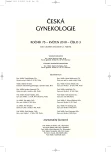Modified classification of microscopic evaluation of vulvovaginal infections
Authors:
J. Mašata 1; M. Poislová 2; A. Jedličková 2; D. Mašátová 2; A. Martan 1
Authors‘ workplace:
Gynekologicko-porodnická klinika VFN a 1. LF UK, Praha, přednosta prof. MUDr. A. Martan, DrSc.
1; ÚKBLD, Klinická mikrobiologie a antibiotické centrum VFN a 1. LF. UK, Praha, přednosta prof. MUDR. T. Zima, DrSc.
2
Published in:
Ceska Gynekol 2010; 75(3): 199-208
Overview
Objective:
The objective of the study is to examine the role of microscopy using stained smears for diagnosis of vulvovavaginal infections.
Design:
Description of different scoring systems.
Settings:
Department of Gynecology and Obstetrics, First Medical Faculty, Charles University; General Teaching Hospital, Prague; Institute of Clinical Chemistry and Laboratory Medicine; Clinical Microbiology and Antibiotic Center, First Medical Faculty, Charles University.
Material and methods:
Presentation of our practical skills in microscopic diagnoses of vulvovaginal infections.
Conclusions:
Vulvovaginal infections are a common problem which we encounter in daily gynaecological practice. Microscopic examination represents the gold standard in the diagnosis of vulvovaginal infections. However, providing microscopy in an outpatient setting is very time-consuming. The vaginal smear can be sent to a laboratory to stain and to be microscopically examined under oil immersion. For this purpose we recommend taking two smears for Gram and Giemsa stain and combining microscopical examination with cultures for detecting the presence of Candida species and for Trichomonas vaginalis. Where appropriate, it is also necessary to obtain cervical smears for detection of C. trachomatis and N. gonnorhoeae infection.
Key words:
vulvovaginal infections, Gram stain, Giemsa stain, bacterial vaginosis, aerobic vaginitis, candida vulvovaginitis, trichomonas vaginalis infection, lactobacillosis.
Sources
1. Amsel, R., Totten, P., Spiegel, C., et al. Nonspecific vaginitis. Diagnostic criteria and microbial and epidemiologic associations. Am J Med, 1983, 74, 1, p. 14-22.
2. Antonio, MA., Hawes, SE., Hillier, SL. The identification of vaginal Lactobacillus species and the demographic and microbiologic characteristics of women colonized by these species. J Infect Dis, 1999, 180, 6, p. 1950-1956.
3. Cibley, LJ. Cytolytic vaginosis. Am J Obstet Gynecol, 1991, 165, 4 Pt 2, p. 1245-1249.
4. Donders, G., Vereecken, A., Salembier, G., et al. Assessment of vaginal lactobacillary flora in wet mount and fresh or delayed Gram’s stain. Infect Dis Obstet Gynecol, 1996, 4, 1, p. 2-6.
5. Donders, G., Vereecken, A., Bosmans, E., et al. Definition of a type of abnormal vaginal flora that is distinct from bacterial vaginosis: aerobic vaginitis. BJOG, 2002, 109, 1, p. 34-43.
6. Ferris, M., Masztal, A., Aldridge, K., et al. Association of Atopobium vaginae, a recently described metronidazole resistant anaerobe, with bacterial vaginosis. BMC Infect Dis, 2004, 4, 5.
7. Giraldo, P., von Nowaskonski, A., Gomes, FA., et al. Vaginal colonization by Candida in asymptomatic women with and without a history of recurrent vulvovaginal candidiasis. Obstet Gynecol, 2000, 95, 3, p. 413-416.
8. Jirovec, O., et.al. Parazitologie pro lékaře. Praha: Avicenum, 1977.
9. Loiudice, L., De Vito, D., Abbatecola, T., et al. Detection of Leptotrix vaginalis in obstetric pathology. Clin Exp Obstet Gynecol, 1982, 9, 3, p. 148-153.
10. Masata, J., Jedlickova, A., Poislova, M., et al. Současné možnosti diagnostiky vulvovaginálních infekcí. Čes Gynek, 2010, 2, 111-117.
11. Mašata, J., Jedličková, A., et. al. Infekce v gynekologii a porodnictví. Praha: Maxdorf, 2004, 371 s.
12. Nugent, RP., Krohn, MA., Hillier, SL. Reliability of diagnosing bacterial vaginosis is improved by a standardized method of Gram stain interpretation. J Clin Microbiol, 1991, 29, 2, p. 297-301.
13. Schwebke, J., Hillier, S., Sobel, J., et al. Validity of the vaginal Gram stain for the diagnosis of bacterial vaginosis. Obstet Gynecol, 1996, 88, 4 Pt 1, p. 573-576.
14. Sobel, JD. Desquamative inflammatory vaginitis: a new subgroup of purulent vaginitis responsive to topical 2% clindamycin therapy. Am J Obstet Gynecol, 1994, 171, 5, p. 1215-1220.
15. Solomon, D., Davey, D., Kurman, R., et al. The 2001 Bethesda System: Terminology for Reporting Results of Cervical Cytology. JAMA, 2002, 287, 16, p. 2114-2119.
16. Spiegel, CA., Amsel, R., Holmes, KK. Diagnosis of bacterial vaginosis by direct gram stain of vaginal fluid. J Clin Microbiol, 1983, 18, 1, p. 170-177.
Labels
Paediatric gynaecology Gynaecology and obstetrics Reproduction medicineArticle was published in
Czech Gynaecology

2010 Issue 3
Most read in this issue
- G spot – myths and reality
- Incidence of congenital heart defects in the Czech Republic – current data
- Existence of the preperitoneal fatty plug and hernia in obtorator canal
- Modified classification of microscopic evaluation of vulvovaginal infections
